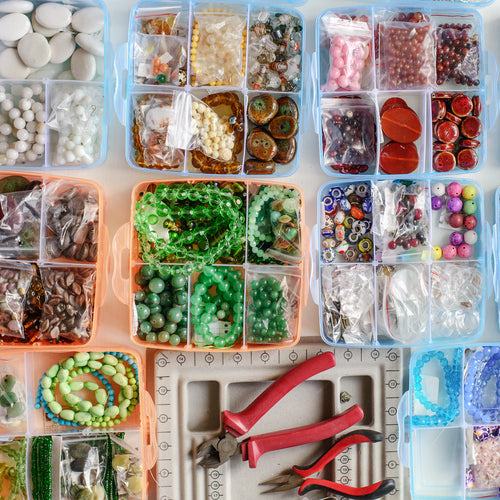
5 Jeweling Mistakes to Avoid When Handling Gemstone Beads
Gemstone beads are amazing additions to any piece you create. With their interesting textures, unique colors, and eye-catching patterns, it is no surprise that gemstone beads are in high demand for do-it-yourself jewelers. Add in the health benefits often associated with these gemstones, like aiding in pain relief or calming the mind, and you have a perfect combination of fabulous and beneficial designs.
Unfortunately, for many novice jewelry makers, working with gemstones can prove to be a challenge. With each stone having its own personality, failing to understand how they must be handled can easily turn a detailed design into a disaster. Knowing in advance certain pitfalls that may cause issues down the road will help guarantee your vision can become a reality. Here are some of the top mistakes bead workers make when handling and building jewelry with gemstone beads.
1. Not Cleaning Your Beads
One of the most common mistakes seen when using gemstone beads is failing to clean them. Without properly washing your beads prior to storage and use, you allow leftover dyes, oils, or debris to remain on their surfaces. Choosing to let this detritus remain guarantees a batch of scuffed and scratched stones when it comes time to create your piece. This debris can also compromise the integrity of the stone, causing a possible chip or break later as well.
2. Using the Wrong Cleanser

Working with semi-precious and precious beads requires time and research. Each type of stone has certain properties that dictate what cleansing process to use. Most stones can be safely washed in lukewarm or cool water with soap, but assuming soap is okay to use for any stone would be folly. Certain gemstone beads, like freshwater pearls, find soaps to be too abrasive, stripping them of their shine. Searching for a perfect, specialized cleanser is a necessity for these softer gems in order for them to keep their natural glow.
3. Steaming or Boiling Your Beads
For many, the idea of using soaps or cleaners on their newly purchased beads is reprehensible. In these instances, opting to steam or boil the beads to clean them properly may seem like a great option. Unfortunately, this is not the case. Steaming or boiling gemstones will often cause a large amount of breakdown due to the high temperatures.
While some of the harder stones can handle heat without an issue, softer stones are generally unable to handle the temperature spike and will fracture or break. Remembering to use cool or warm water when scrubbing your beads is always the safest option to ensure a shiny, clean surface without the possibility of damage.
4. Improper Storage

Inadequately storing your items is a surefire way to guarantee damage will occur. Haphazardly tossing them into a bin, bowl, or tray will not only intermingle your gems with your regular beads, making them harder to locate, but the variety of hardness levels can spell trouble for the beads’ integrity. Placing them in a box with beads that rate higher on a Mohs Hardness Scale means you can expect to find your precious stones fragmented or otherwise damaged when it comes time to build your jewelry.
Placing your gems in a container with assigned sections is the first step in proper storage. The individual compartments will keep the stones organized and safe. Placing some cotton along the top of the container will also help make sure your beautiful bounty is tucked away nice and safe until you are ready to convert those individual beads into a fabulous statement piece.
5. Selecting the Wrong Bead Reamer
Finding the perfect gemstone bead only to realize it has too small of a hole, an irregular edge, or some other section that needs a quick file to smooth it down is a common occurrence when working with beads of any kind. Picking up your handy bead reamer to remedy any issues will always be your first instinct. However, when working with gemstones, using any conveniently located bead reamer may destroy your beautiful stones. If the grit is too harsh, rather than creating a custom eye-catching piece, you’ll see your unique gems crumbling away into dust.
Checking that Mohs Hardness Scale and determining what each stone’s level of strength is and selecting a corresponding reamer is always the safest option. Stones like pearls, amber, or coral need a much softer texture than you would use on a harder stone like garnet.
Final Thoughts
Properly handling your gemstone beads will be a breeze once you know to avoid these common mistakes. By simply taking the time to research the Mohs Hardness Scale of each stone, you can easily research the proper way to clean, store, and prepare your gem. So, grab your favorite brand of bead reamer—in the appropriate grit, of course; set out that beautiful bounty of stones; and make something extraordinary.


